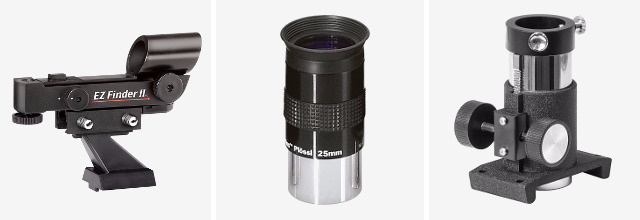
You might have noticed that we’re big fans of Dobsonian telescopes especially for beginners. They’re simple to setup, easy to operate and provide excellent value for the aperture size. The Orion SkyQuest XT6 Classic Dobsonian Telescope is no exception. It’s a very good telescope that is popular with beginners and highly recommended. Priced at[amazon_link asins=’B001DDW9UW’ template=’PriceLink’ store=’telescopeadviser-20′ marketplace=’US’ link_id=’a0bc6b20-760b-11e7-a047-117a7f88ec2f’]the XT6 is over $100 cheaper than the larger XT8 and offers better value and performance than the smaller XT4.5. While we think that 8-inch Dobsonians are the sweet spot for beginners, a 6-inch is the next best thing and a good way to save some money.
Optics
The XT6 is a Newtonian reflector telescope. It is well-built with nice fit and finish for the price and should last a lifetime. The primary mirror has a 6-inch (150mm) aperture with a focal length of 1200mm and a focal ratio of f/8. There is no spherical aberration as the primary mirror is parabolic. Coma will not be as apparent as with the Orion StarBlast 6 Astro Reflector Telescope. The central obstruction from the secondary mirror is only 23 percent and shouldn’t be noticeable. The optical performance is excellent and excels with deep-sky objects.
Mount
The Dobsonian base is a simplified altazimuth mount also known as a rocker box. It’s constructed of wood with three basic Teflon pads for azimuth bearings and UHMW polyethylene pads for the altitude bearings. The motions are smooth and the base is very stable which means no vibrations. The optical tube is secured to the base with a system of heavy-duty tension springs which also keep it balanced.
Finder
Using the EZ Finder II is pretty simple and straightforward. The EZ Finder II is a battery-powered red dot finder with zero power (no magnification). It helps you locate celestial objects and accurately aim the XT6 in their direction. You can adjust the position of the telescope while looking through the finder’s viewing window until the red dot is aligned with the target object you wish to observe. Then look through the telescope’s eyepiece and the object will be in view. Remember to turn off the EZ finder when not in use to preserve the battery. The majority of people prefer a finderscope that provides magnification instead of a red dot finder. Replacing the red dot finder with a finderscope is an easy upgrade to make at a later time.

Eyepiece
The XT6 comes with a 1.25″ Sirius Plossl 25mm eyepiece. The eyepiece is pretty good quality and provides 48x magnification with a 52° apparent field of view. It’s unfortunate that only a single eyepiece is included. We recommend picking up at least one additional eyepiece like a 6mm eyepiece which would provide 200x magnification and would show plenty of lunar and planetary detail. Be aware that the image shown in the eyepiece will be upside down and flipped 180 degrees. This is normal for reflector telescopes.
Focuser
The focuser is a basic 1.25″ rack and pinion made of plastic and comes with a dust cap. It’s a decent focuser with fairly smooth focusing but there are superior options out there. It’s possible to make a minor modification to improve the smoothness of the focusing. Follow this step-by-step guide to replace the standard thick grease with lithium grease. Switching the focuser for a better one is another easy upgrade you could make in the future.
Collimation
The primary and secondary mirrors will require periodic adjustments called collimation. This is a simple process that aligns the optics to ensure optimal image quality. Collimating a telescope can seem overwhelming at first but trust us, it’s not complicated. The instruction manual includes detailed directions and this video by Orion explains how it’s done. To make collimation easier, the XT6 comes with a simple collimation cap and the primary mirror is center-marked. You will need a Phillips screwdriver that is not included.
Views
With optimal viewing conditions and the right eyepiece, you can expect to see amazing views of the moon and planets including:
- craters of the moon
- Jupiter, its 4 moons, cloud bands and Great Red Spot
- Saturn’s rings, Cassini Division, and largest moon Titan
- Mars as a red disk
- Mercury and Venus and their changing phases
- Neptune and Uranus as tiny colored disks
- comets
Under dark skies, the 6-inch aperture is large enough to show plenty of deep-sky objects. Expect to see galaxies, nebulae, and globular and open star clusters.
Astrophotography
For astrophotography, it is possible to capture short exposure photos of the moon and planets with the XT6. However, Dobsonian mounts aren’t suited for taking long exposure images of deep-sky objects. They are better for viewing than for photography.
Dimensions
The optical tube has a weight of 13.5lbs and the base weighs 20.9lbs for a combined weight of 34.4lbs. The optical tube is 45.5-inches long and should fit in the back seat of a car. The base has a handle for easier transport. Although the XT6 is slightly lighter than its larger XT8 cousin (less than 7lbs lighter), there isn’t really a difference in portability. The optical tubes are roughly the same length and the bases weigh about the same.
Kit
Orion also offers a kit version of the XT6 for about $30 more that includes a few extras. These extras include a 2x Barlow lens (worth about $40 on its own), a RedBeam mini LED light, a planisphere, Moon Map and Telescope Observer’s Guide book by Richard J. Bartlett. The package is a good value especially if you were planning to buy a Barlow lens. The 2x Barlow would double the magnification of the included 25mm eyepiece to 96x.
Pros and Cons
- Large aperture
- Easy to use
- Excellent for viewing deep-sky objects
- Better value and performance than XT4.5
- Includes a collimation cap
- Only one eyepiece included
- Need a higher power eyepiece for moon and planets
- Limited accessories








